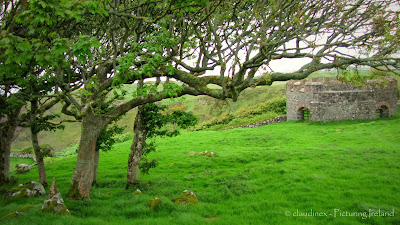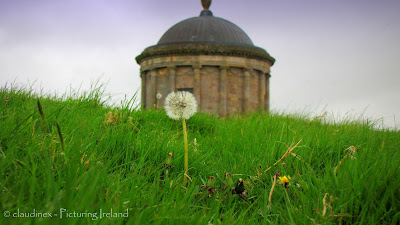This miniature temple is one of the most peculiar buildings in Ireland: spectacularly perched on the edge of a cliff high above the sea, it has become an iconic landmark along the north-western coastline.
(scroll down for german version)
The temple stands on the grounds of the beautifully set Downhill Demesne near the small town of Castlerock in County Derry. The estate was once home to Frederick Hervey, the 4th Earl of Bristol and Bishop of Derry. The Earl and his wife Elizabeth, along with their five children moved to this manor house in the early 1770s, after he was appointed Bishop of Derry. The "Earl Bishop", as he was known, was a very colourful character. He was coined "the most worldly, most eccentric, most talked-about priest in the Church of Ireland".
He was a well-travelled and cultural man, with a grand collection of art and paintings by famous artists like Rubens, Dürer and Tintoretto. But he was also surrounded by rumours of scandal, he was reputed to have had many mistresses, earning him the nickname "the English Casanova". King George III was even quoted to have referred to him as "that wicked prelate". The Earl Bishop died in 1803 while travelling in Italy and apparently wished that his body be shipped back home in a cask of sherry.
 |
| The view of Mussenden Temple from Downhill Strand |
 |
| The cliffs of Derry |
He was a well-travelled and cultural man, with a grand collection of art and paintings by famous artists like Rubens, Dürer and Tintoretto. But he was also surrounded by rumours of scandal, he was reputed to have had many mistresses, earning him the nickname "the English Casanova". King George III was even quoted to have referred to him as "that wicked prelate". The Earl Bishop died in 1803 while travelling in Italy and apparently wished that his body be shipped back home in a cask of sherry.
 |
| The Downhill Demesne |
During his life time, the Earl Bishop was very fond of art and architecture. He was also very fond of his married cousin Frideswide. In 1783 he built her a temple on the edge of the cliff overlooking the sea and the coast. The temple was inspired by the Temple of Vesta in Tivoli in Italy and was intended to serve as a summer library. The relationship between the flamboyant Earl Bishop and his cousin was the subject of many speculations, they were said to have spend a little too much time together. Frideswide was married to the elderly banker Daniel Mussenden and the scandal surrounding her and the Earl Bishop may have led to her untimely death in 1785 - she died only 22 years old, just before her temple was finished.
 |
| On the inside, looking out |
 |
| Downhill Strand from above |
 |
| The ruins of the manor house |
Today, the demesne is open to the public year round. The once splendid manor house is only an empty shell now, but the grounds and especially Mussenden Temple are a sight to behold. Cliff erosion has brought the temple precariously close to the edge, so that in 1997 cliff stabilisation work had to be carried out to prevent the small temple from plummeting down into the sea.
 |
| Close to the edge |
The view from the temple is truly breathtaking - on a clear day you can see all along the coastline, to the west from Downhill Strand to Magilligan Point and beyond towards County Donegal and eastwards to the seaside resorts Portrush, Portstewart and further towards Fair Head in County Antrim.
german version:
Dieser Miniatur Tempel ist eines der seltsamsten Bauwerke Irlands: spektakulär am Rande einer Klippe hoch über dem Meer gelegen wurde er zu einem der markantesten Wahrzeichen der Küstenlandschaft im Nordwesten.
Der Tempel gehört zum wunderschön gelegenen Downhill Anwesen in der Nähe des Städtchens Castlerock in der Grafschaft Derry. Das Anwesen gehörte einst Frederick Hervey, dem 4. Earl von Bristol und Bischof von Derry. Der Earl und seine Frau Elizabeth bezogen das Herrenhaus mit ihren fünf Kindern in den 1770er Jahren, nachdem der Earl zum Bischof von Derry berufen wurde. Der "Earl Bischof" wie er genannt wurde, war ein sehr interessanter Charakter. Er wurde der "weltlichste, exzentrischte und meist diskutierteste Priester der Irischen Kirche" genannt.
Er war ein weit gereister und kultureller Mann mit einer großen Kunst- und Bildersammlung von Malern wie Rubens, Dürer und Tintoretto. Aber er wurde auch von Skandalgerüchten umgeben, er soll viele Affären gehabt haben, was ihm den Namen "der englische Casanova" eingebracht hat. Der englische König George III soll ihn sogar als "diesen verruchten Prälaten" tituliert haben. Der Earl Bischof verstarb im Jahre 1803 auf Reisen in Italien und soll gewünscht haben, dass seine sterblichen Überreste in einem Sherryfass zurück nach Hause gebracht werden.
 |
| The summer house or "Belvedere" on the grounds of the demesne |
Zu Lebzeiten war der Earl Bischof sehr angetan von Kunst und Architektur. Er soll auch sehr angetan von seiner verheirateten Cousine Frideswide gewesen sein. 1783 baute er ihr einen Tempel am Rande der Klippen mit Blick auf das Meer und die Küste. Der Tempel war inspiriert vom Tempel von Vesta in Tivoli in Italien und sollte als Sommerbücherei dienen. Die Beziehung zwischen dem Earl Bischof und seiner Cousine war Inhalt vieler Spekulationen, es wurde gemunkelt, sie hätten viel zu viel Zeit miteinander verbracht. Frideswide war mit dem älteren Bankier Daniel Mussenden verheiratet und der Skandal der sie und den Earl Bischof umgab, könnte zu ihrem frühzeitigen Ableben im Jahre 1785 beigetragen haben - sie starb nur 22jährig, kurz bevor ihr Tempel fertig gebaut war.
Nach dem Tod des Earl Bischofs erbte sein Cousin und der Bruder von Fridewide, der Reverend Henry Bruce das Anwesen. Im Jahre 1851 zerstörte ein Feuer Teile des Herrenhauses und auch Teile der eklektischen Kunstsammlung. Das Haus wurde renoviert und blieb im Besitz der Hervey-Bruce Familie bis 1946. Dann verfiel das Anwesen zusehends, bis der National Trust das Grundstück 1980 erwarb.
Heute ist das Anwesen ganzjährig der Öffentlichkeit zugänglich. Das einst prächtige Herrenhaus ist nur mehr eine Ruine, aber das Gelände und vor allem der Mussenden Tempel sind absolut sehenswert. Durch die Erosion der Klippen ist der Tempel mittlerweile gefährlich nah an die Kante gerutscht, deshalb mussten 1997 auch die Klippen stabilisiert werden, damit der kleine Tempel nicht ins Meer plumpst. Der Ausblick vom Tempel ist atemberaubend - bei klarer Sicht kann man die gesamte Küste überblicken, im Westen vom Downhill Strand über Magilligan Point bis nach Donegal und im Osten von den Badeorten Portrush und Portstewart bis nach Fair Head in der Grafschaft Antrim.
















No comments:
Post a Comment